How do you arrive at a list of the greatest violinists of all time? It’s the instrument that inspired solo masterpieces from Bach to Bartók, that leads the way in chamber groups and symphony orchestras, that is equally at home in gypsy, klezmer and jazz groups alike. Just where would music be without the wonderful violin?
And in the right hands, few instruments can match the violin for displays of thrilling virtuosity, for expressing the full gamut of human emotions and for sheer beauty of sound. As a result, few instrumentalists have had quite the same legendary status as enjoyed by the greatest violinists.
In fact, stories concerning the violin and those who play it have sometimes gone beyond the realms of reality. For instance, at his prime in the 1820s, Niccolò Paganini was believed by some to made a pact with the devil himself.
Greatest violinists ever
We asked 100 of today’s best players to tell us the violinists who have inspired them most. Each had three choices, with the stipulation that they must have heard them either on disc or live. We then totted up the results to produce the following Top 20 of the greatest violinists of the recorded era…
You may also enjoy our list of the greatest violin concertos of all time.
Contents
The greatest violinist of all time
Greatest violinists: 2 to 5
The greatest violinists: 6 to 10
Greatest violinists: 11 to 20
The greatest violinists: 16 to 20
The greatest violinist of all time
01 David Oistrakh
(1908-74) Ukrainian
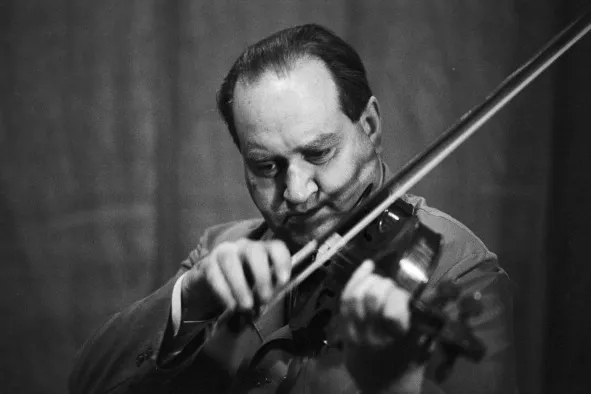
Oistrakh's dream of becoming a violinist started when, aged three, he was given a toy violin. His father, himself a keen amateur violinist, also introduced him to klezmer tunes. Their expressive style and virtuosity became an essential part of the budding young violinist’s musical makeup which he eventually passed to his students.
Oistrakh was five when he began lessons with his only official teacher, Pyotr Stolyarsky. A pit musician from the Odessa Opera, Stolyarsky was a mediocre player. Yet he was a remarkable pedagogue, also teaching such luminaries as Nathan Milstein and Elizaveta Gilels.
Stolyarsky instilled in his pupils the habit of picking up their violin and warming up first thing before breakfast and last thing before going to bed. Oistrakh maintained this habit for the rest of his life. Stolyarsky also nurtured the long legato bow of which Oistrakh became master. He told his pupils: ‘Imagine your bow is your salary. You need to spend it all, but over a single long period.’
David Oistrakh: early breakthroughs
Continuing his studies with Stolyarsky at the Odessa Conservatory, Oistrakh graduated aged 18 in 1926. He performed Prokofiev’s First Violin Concerto just three years after its Parisian premiere. Still a local celebrity, he was spotted two years later by the great conductor Nikolai Malko. The latter invited Oistrakh to make his Leningrad debut with the already celebrated Philharmonic Orchestra.
Shortly afterwards, Oistrakh settled in Moscow where he married and had a son, Igor. The latter would eventually become almost as celebrated a violinist as his father. Oistrakh’s modest and collegial personality, contrary to the bitter, ulcer-inducing rivalry of so many Soviet musicians, readily won him friends among fellow musicians, and his appointment on the staff of the Moscow Conservatoire in 1934 reinforced his association with such violinists as Abram Yampolsky and Lev Tseitlin, and the pianists Heinrich Neuhaus and Vladimir Sofronitsky. All these performers deepened Oistrakh’s musical perception and intelligence.
Following his success in several competitions, including winning second prize at the 1935 Wieniawski Contest in Poland (Ginette Neveu winning first prize), Oistrakh triumphed in the 1937 Ysaÿe Concours in Brussels, so establishing himself as the Soviet Union’s leading violinist. He worked with all the leading Soviet composers, inspiring and closely collaborating on the creation of several major works including violin concertos by Shostakovich, Myaskovsky and Khachaturian, and violin sonatas by Prokofiev and Shostakovich.
'A seamless, singing legato'
His technique – note-sure and cleanly articulated even in the most virtuosic passagework – was crowned by a seamless, singing legato, apparently unbroken by any change in bow direction. Yet Oistrakh’s playing is recognisable not because he coasted, as have so many celebrated violinists, on a generic ‘sound’.
Oistrakh was incisive when appropriate – for instance, when playing Bartók’s First Violin Sonata or Shostakovich’s Violin Concertos. He also had a remarkable ear and feel for sonority, finding an ideal colour for whatever he was playing. Witness the veiled tone quality with which he plays the furtive opening of Debussy’s Sonata. He creates a shadowy yet still expressive tone by bowing over the fingerboard (sul tasto), only blossoming into a full-throated sound when the music finally becomes impassioned at the movement’s end.
Yet he never indulged in histrionics. As his great admirer and friend Yehudi Menuhin said, Oistrakh would ‘dramatise with discretion’, having considered every note and every phrase of the works he performed. Oistrakh so closely identified with whatever repertoire he played – whether Bach, Brahms or Shostakovich – that his listeners became no longer aware of his instrument and the technique with which he played it, but rather heard, as if unmediated, his ‘voice’ and its expression.
ESSENTIAL RECORDING: Brahms: Violin Sonata, Op. 100; Prokofiev: Violin Sonata No. 1 With Sviatoslav Richter (piano) Orfeo C 489 981 B
Check out David Oistrakh on Spotify
Greatest violinists of all time: 2 to 5
2 Jascha Heifetz
(1901-87) Lithuanian-American
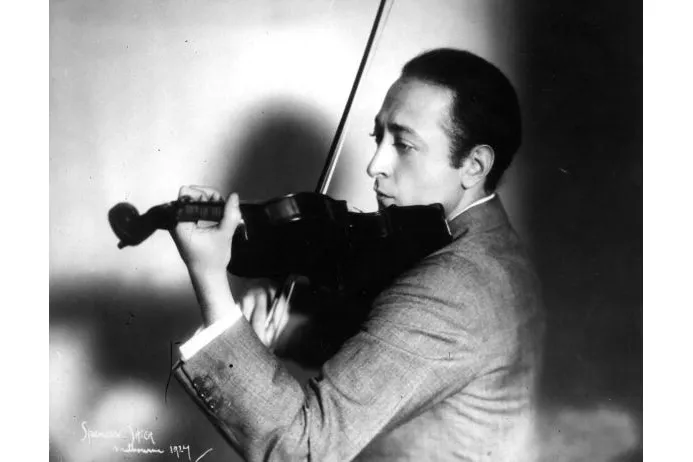
‘Born in Russia, first lessons at three, debut in Russia at seven, debut in America in 1917. That’s all there is to say, really.’ Jascha Heifetz’s summing up of his rise to stardom may seem matter-of-fact. But it does capture something of his predestination in becoming one of the all-time greats.
Born with a musically supercharged DNA, Heifetz couldn’t remember a time when he couldn’t play the violin. It just seems to have been there from the start, waiting to be activated. Like Nathan Milstein, he had lessons with the legendary pedagogue Leopold Auer. This, though, seems to have been more a process of osmosis than actual teaching.
‘Don’t ask me how he did it,’ Heifetz reflected, ‘for I would not know how to tell you.’ The real secret seems to have been Heifetz’s strict regime of practice. ‘If I don’t practise one day, I know it,’ he explained in later life. ‘Two days, the critics know it; three days, the public knows it!’
Where did Heifetz make his American debut?
The American debut Heifetz referred to took place in Carnegie Hall and left the audience shell-shocked. It wasn’t just the fact that Heifetz’s playing was technically in a class of its own. No, they had alsowitnessed an entirely different, modernist way of playing the instrument. The prevailing tendency had been towards creating a rounded tone of depth and resonance. In contrast, Heifetz’s meticulously honed technique was focussed on absolute clarity.
He bowed with swift, no-nonsense, economical strokes, matched by a precision left hand free of extraneous movement. This, coupled with his trademark facial impassivity and high-velocity execution, created the strange impression of someone in a trance-like state. As a result, Heifetz’s playing sustained a remarkable level of intensity. ‘There is no top,’ he once reasoned. ‘There are always further heights to reach.’
Although he was an outstanding exponent of Bach and Beethoven, Heifetz’s repertoire was centred on the Romantic period which he considered ‘already so overloaded with sentiment that all you have to do is play the notes – it will come out anyway!’ He did draw the line at most contemporary music though.
‘I play works by contemporary composers for two reasons,’ he reasoned, half-jokingly. ‘First to discourage the composer from writing any more, and secondly to remind myself how good Beethoven is.’ That said, Heifetz premiered and recorded definitive accounts of outstanding concertos by Castelnuovo-Tedesco, Walton, Korngold and Rózsa. Indeed, despite his disparaging comments, the music of his contemporaries ultimately inspired him to produce some of his finest playing on disc.
Unquestionably one of the greatest violinists of all time - and, for many, sitting right at the top.
ESSENTIAL RECORDING: Walton/Castelnuovo-Tedesco Violin Concertos etc. With Philharmonia/William Walton, LA Philharmonic/Alfred Wallenstein etc Naxos 8.111367
Check out Jascha Heifetz on Spotify
3 Fritz Kreisler
(1875-1962) Austrian
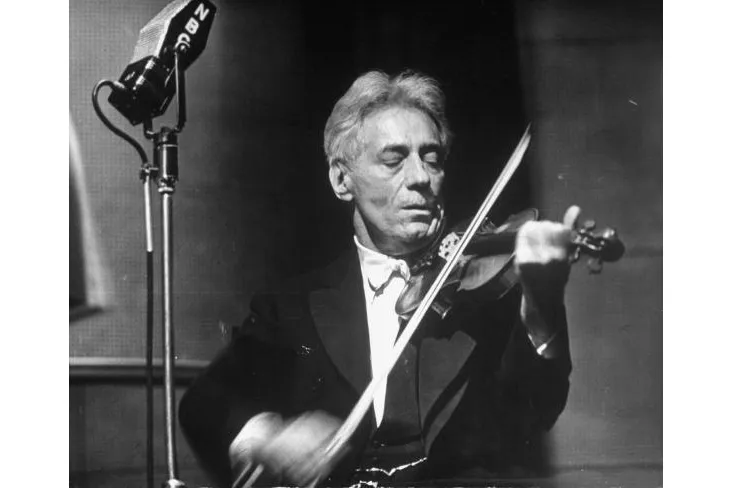
Born in Vienna in 1875, Fritz Kreisler was a violinist like no other: a musician whose unmistakeable sound seemed to embody the essence of the Viennese Romantic style.
During his studies there and in Paris, Delibes and Bruckner, Dont and Massenet were among his professors. Yet as a youth he auditioned for the Vienna Philharmonic, only to find himself turned down by its leader, Arnold Rosé. He was so dispirited that he nearly enrolled to study medicine instead. This was the first of a number of narrow escapes in both his career and his life.
His reputation as a soloist was established by a concert with the Berlin Philharmonic under Nikisch and some tours of America in the first years of the 20th century. He served and was wounded in World War I; in 1938 he escaped Vienna for Paris and subsequently, on the outbreak of World War II, moved to America. He spent his last years living in New York, where another lucky escape involved a week in a coma after being knocked down by a lorry.
'There's no mistaking the sound of Kreisler'
Kreisler’s style in certain ways is epitomised by the violin and piano miniatures he wrote and performed. He often disguised these as pastiches of Baroque composers, when they were in fact his original work. The waltzes Liebesleid, Liebesfreud and Schöne Rosmarin are among those that remain popular encores with today’s soloists.
But if there remains a lingering impression that Kreisler was the arch salon violinist, it is somewhat misleading. His pianist duo partner on a few precious recordings of larger-scale sonatas was none other than Sergey Rachmaninov and he also left important recordings of numerous major concertos. Sadly, though, not of the Elgar Violin Concerto, which was written for him. He made modifications of his own to it before giving its premiere in 1910.
There’s no mistaking the sound of Kreisler. He was the ultimate ‘golden age’ violinist: one whose personality, distinctive tone and expressive, seductive way with vibrato, portamento and rhythm are instantly recognisable, yet always rooted in empathy with the genuine spirit of the music. His tone has a sweetness, soulfulness and songfulness that has never been surpassed.
ESSENTIAL RECORDING: Kreisler: Original Compositions & Arrangements EMI 476 8402
4 Yehudi Menuhin
(1916-99) American
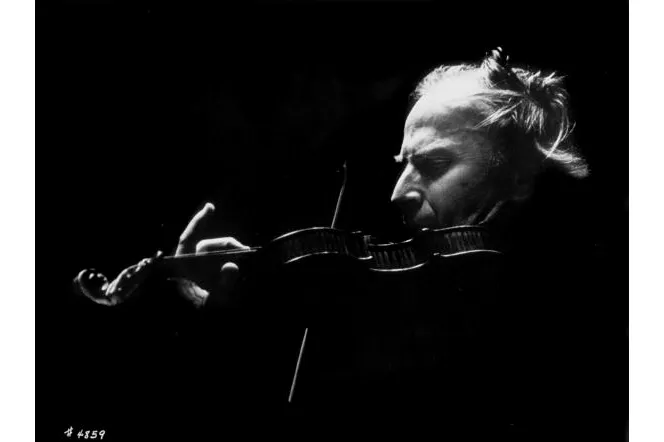
Next in our list of greatest violinists is a name who will be familiar to many. Born in New York, the son of Jewish immigrants from Belarus, Yehudi Menuhin enjoyed a meteoric rise to fame as a child prodigy. He went on to become one of the few violinists who can be viewed as truly iconic.
His work was frequently groundbreaking, in ways that ranged from recording Elgar’s Violin Concerto under the baton of the composer in 1932 to playing jazz with Stéphane Grappelli and collaborating with Ravi Shankar. He gave a number of significant world premieres, including that of Bartók’s Solo Sonata and the Walton Violin Sonata. Another vital moment was when, in 1945, he and Benjamin Britten travelled to the liberated concentration camp of Bergen-Belsen and played to the survivors and Allied soldiers in shocking circumstances that are said to have affected Menuhin for years.
Who did Yehudi Menuhin teach?
In 1962 he founded the Yehudi Menuhin School with the aim of providing top-level tuition for exceptionally gifted young musicians. The school went on to train some of the UK’s most significant string players and pianists. Nigel Kennedy, Melvyn Tan, Tasmin Little and Alina Ibragimova are among its alumni. He was also the founder of Live Music Now, the pioneering outreach organisation, and of the Yehudi Menuhin International Competition for Young Violinists. He increasingly turned to conducting in the later part of his career, but with rather limited critical success.
Menuhin’s teachers included such distinguished figures as Adolf Busch and George Enescu, whom he idolised. His performances in his prodigy years received ceaseless adulation – yet after the war he started to analyse and rethink his playing. Apparently he decided that ‘for 30 years I’d been holding the bow wrongly’.
Many listeners nevertheless felt that his finest recordings were those of his youth, since they seem less studied and more spontaneous. His playing in general was characterised by sweetness of tone and an unusual spirituality of atmosphere. One of the greatest violinists - and always such a joy to listen to.
ESSENTIAL RECORDING: Bruch & Mendelssohn: Violin Concertos with the Philharmonia Orchestra/Walter Susskind, Efrem Kurtz EMI 965 9262
5 Nathan Milstein
(1903-92) Russian-American
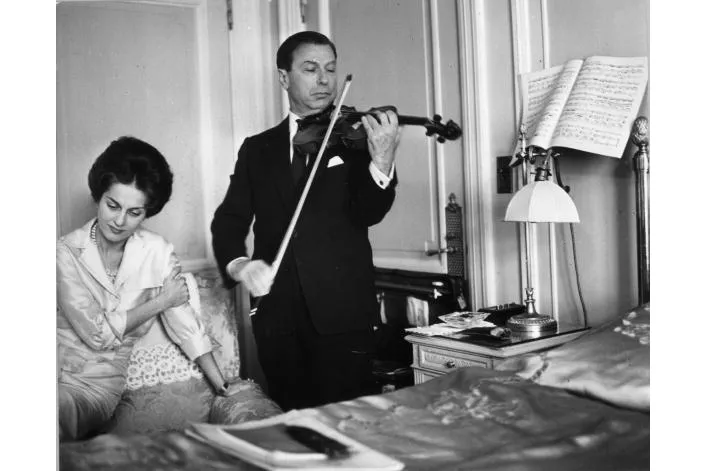
Definitely one of the greatest violinists... and one for whom it was all about the music.
Almost painfully self-effacing and indifferent to fame and fortune, Nathan Milstein was a violinist’s violinist. He lived and breathed the violin almost to the exclusion of anything else. It was his lifelong companion but also a thing of wonder, whose mysteries and challenges he devoted a lifetime to solving.
He was his own sternest taskmaster and learned little from any of his Russian teachers, including the legendary Leopold Auer. He might well have stayed in Russia had it not been for a chance encounter with pianist Vladimir Horowitz, with whom he became close friends. ‘Horowitz invited me round for tea,’ he drily reflected, ‘and I ended up staying three years.’
Who did Nathan Milstein perform with?
Having conquered Mother Russia, the pair made their way to North America. Horowitz hit his audiences like a meteor with his astonishing keyboard bravado. Milstein approached things more by stealth, gently seducing his listeners into a world of extraordinary refinement with his sleight-of-hand technique.
Shortly afterwards, the astonishing young cellist Gregor Piatigorsky joined them to form a ‘million-dollar’ piano trio to rival even Heifetz, Rubinstein and Feuermann. Following World War II, Milstein made London his home. He continued playing at an astonishingly high level of accomplishment until, aged 83, he suffered a nasty fall and had to retire.
Milstein was above all celebrated for his unique tonal lustre, the result of a near-perfect playing mechanism. He coaxed the sound out of his violin by taking unusually long bow-strokes at a relatively low pressure and was no less gentle with the fingers of his left hand which were more about precision than strength, resulting in intonation of ringing purity. The refinement of his playing proved every bit as seductive in Glazunov and Saint-Saëns concertos as it was in the music of Bach and Mozart.
ESSENTIAL RECORDING: The Very Best of Milstein EMI 094 7972
Greatest violinists of all time: 6 to 10
6 Gidon Kremer
(b.1947) German/Latvian
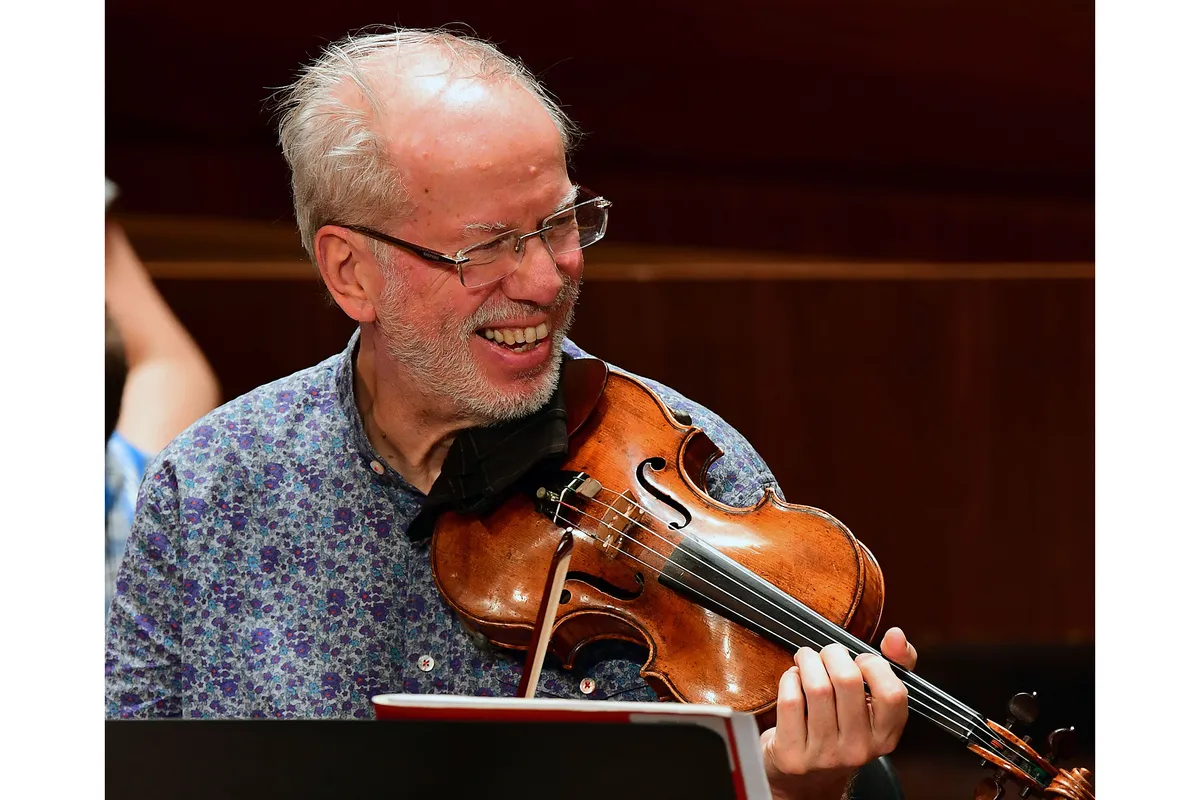
In a recent interview Gidon Kremer stated his aesthetic credo: ‘I am attached to music that speaks to you and does not just manipulate your sophistication. The point is not only to say something unheard of before but to say it in a language of emotion.’
Not so different from many latter day Soviet violinists, one might say. Yet how many appear so at home in both Beethoven’s Violin Sonatas and Berg’s Violin Concerto, playing these idiomatically and yet with refreshing lack of affectation?
Credit for this lies both with Kremer, unquestionably one of the greatest violinists of his or any era, and his teacher, David Oistrakh. The singing tone of his mentor is evident in all Kremer’s playing, and not just in the repertoire they share.
As winner of the 1969 Paganini Competition, followed by the Tchaikovsky International Competition in 1970, Kremer’s ability and virtuosity simply could not be doubted. However, Kremer fell out of favour with the Soviet authorities when he insisted on playing whatever repertoire he pleased, including the officially disapproved music of Schnittke.
Kremer was allowed to retain his Soviet citizenship. However, he was no longer permitted to perform within the Soviet Union. Effectively exiled, Kremer – himself half German-Jewish and half Latvian – settled in Germany. Identifying himself as a Baltic musician, he formed the ensemble Kremerata Baltica, using this as a platform to champion contemporary composers from that region and of the former Soviet empire.
ESSENTIAL RECORDING: Silvestrov: Post Scriptum; Dedication With Vadim Sakharov (piano); Munich Philharmonic/Roman Kofman Apex 2564 69896-3
7 Joseph Szigeti
(1892-1973) Hungarian
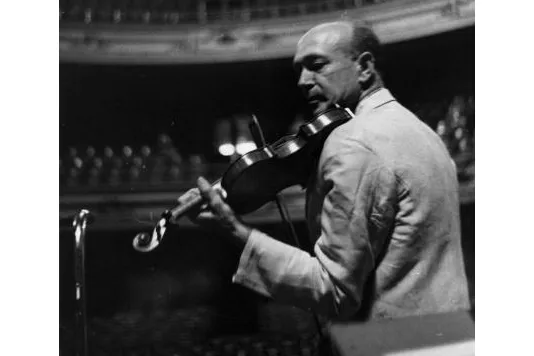
A child prodigy who trained in Budapest with the great pedagogue Jenö Hubay, Joseph Szigeti was a prime figure in a generation of Hungarian violinists whose technical finesse, penetrating musicianship and magnetic personalities left a vital legacy for the future. He escaped wartime Europe for America in 1939, but spent his last years, from 1960, living and teaching in Switzerland.
Studies with the composer Ferruccio Busoni gave Szigeti a strong intellectual basis for his playing, and his close friendship with Bela Bartók proved just as crucial, sparked by an unlikely meeting in a Swiss sanatorium where Szigeti was recovering from TB and Bartók from pneumonia.
The two made definitive recordings of Bartók’s works for violin and piano and, with Benny Goodman on the clarinet, Contrasts. During the course of a long career, Szigeti left a substantial quantity of superb recordings and taught extensively. He published his influential treatise, Szigeti on the Violin, in 1969.
Szigeti was described as ‘an incredibly cultured musician’ by Nathan Milstein. Yehudi Menuhin reflected that ‘while Enescu was a force of nature, Szigeti, slender, small, anxious, was a beautifully fashioned piece of porcelain’.
Menuhin also commented on the sharpness of his mind and his ‘pernicketiness’ as a competition juror. His rigorously intellectual approach – a very pure musicianship who eschewed indulgence in virtuoso display – seems sometimes to have puzzled his contemporaries, but drew increasing public admiration as time went by and the fashions of Romanticism waned. Now, if not always before, he is recognised as one of the greatest violinists.
ESSENTIAL RECORDING: Bartók: Contrasts and Rhapsody No. 1 With Bela Bartók (piano) & Benny Goodman (clarinet) Naxos 8.111343
Check out Joseph Szigeti on Spotify
8 Ginette Neveu
(1919-49) French
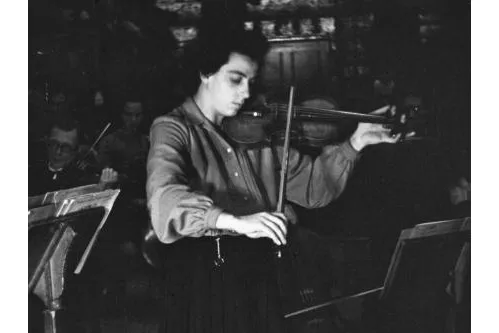
The first woman in our list of greatest violinists: and what a performer.
Ginette Neveu’s tragic death in a plane crash at the age of 30 deprived the musical world of a violinist who had made a tremendous impact with the power and beauty of her tone. Her emotional intensity makes her recordings of Chausson’s Poème and the Sibelius Violin Concerto some of the finest, and best loved, in the catalogue.
Born in Paris, Neveu was the great-niece of the organist and composer Charles-Marie Widor. She trained with the finest of professors, including George Enescu, Nadia Boulanger and Carl Flesch. A public debut came at just seven, and at 15 she took first prize at the Wieniawski Competition. David Oistrakh pulled in in second place.
She toured extensively from then on, though her career was interrupted by the advent of World War II. Her frequent accompanist was her pianist brother Jean-Paul, who died with her in the crash. Among many highlights in a remarkable but far-too-short career, she gave the world premiere of Poulenc’s Violin Sonata.
Her playing was characterised by an ability to combine that vast intensity with fulsome and precise tone. Her sound (and her appearance too, according to some) was often thought of as virtually ‘masculine’. It was said that when her body was recovered, she was still clutching her Stradivarius in her arms.
ESSENTIAL RECORDING: Ginette Neveu: The Complete Studio Recordings.
Documents 600057
9 Isaac Stern
(1920-2001) Polish-American
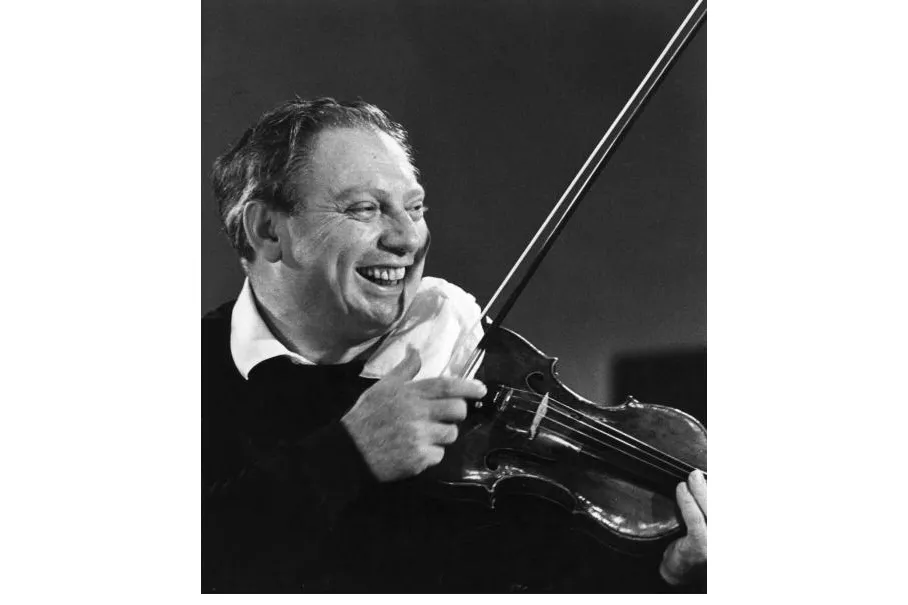
A leading statesman among 20th-century violinists, Isaac Stern was respected for his probing musical insights as much as for his scorching virtuosity. There was an intensity about Stern’s playing during the 1950s and ’60s in particular that remains utterly unique.
From Lalo and Sibelius to Bruch and Tchaikovsky – especially when working with conductor Eugene Ormandy and his ‘fabulous Philadelphians’ – Stern made music come alive with an electrifying pulse. As each piece unfolded, he revealed its underlying narrative, its expressive nerve-centre with an almost child-like sense of awe and wonder.
Stern was instinctively drawn towards the established masterpieces of the Western tradition. Of the more than 100 albums he recorded, only three or four might be said to be of the ‘showpiece’ variety. He was also a devoted chamber musician, most notably with his legendary piano trio (alongside Leonard Rose and Eugene Istomin) and, in his twilight years, one of the all-time great piano quartets with Jaime Laredo, Yo-Yo Ma and Emmanuel Ax.
Above all, Stern, who was born in Poland but moved to the US at a young age, was a natural communicator who was passionate about his art. ‘I have a responsibility to pass on to the next generation what I learned from my teachers,’ he once said. ‘It keeps me young and reminds me where I came from.’
ESSENTIAL RECORDING: Isaac Stern: The Soul of the Violin
Sony 88697 573872
Check out Isaac Stern on Spotify
10 Itzhak Perlman
(b.1945) Israeli-American
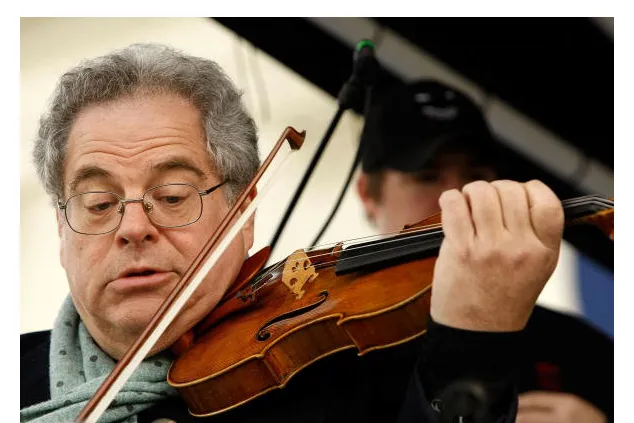
No virtuoso in history has made playing the violin appear as nonchalant as Itzhak Perlman. By the time the polio-stricken 13 year-old made his sensational American television debut playing the finale of Mendelssohn’s E minor Concerto on Ed Sullivan’s Caravan of Stars, the essentials of his mature playing were already in place – the almost carefree bowing style, the large left hand that effortlessly negotiated the violin almost without the need to change position, a sumptuous sound of captivating tonal allure and a joyous stage presence that radiated warmth and enthusiasm.
Equally comfortable in front of a film camera as a studio microphone, Perlman was one of an exceptional group of world-class young musicians – including Daniel Barenboim, Vladimir Ashkenazy, Jacqueline du Pré and another of our greatest violinists, Pinchas Zukerman – who emerged in the 1960s as already fully fledged masters of their craft.
As scintillating when playing JS Bach, Mozart and Beethoven as he is when soaring aloft with Tchaikovsky, Brahms and Elgar, Perlman’s greatest gift is his ability to make the music of composing’s second, third and even fourth raters sound like masterpieces. When it comes to the virtuoso encore repertoire and the concertos of Khachaturian, Castelnuovo-Tedesco, Korngold, Wieniawski and Goldmark, he is in a class of his own.
ESSENTIAL RECORDING: Violin Encores
EMI 476 9572
Greatest violinists of all time: 11 to 15
11 Arthur Grumiaux
(1921-86) Belgian

Arthur Grumiaux was one of the great aristocrats of the violin but was also a remarkable pianist, as witness a unique 1957 recording he made of Brahms and Mozart sonatas playing both parts! The complete opposite of a temperamental maestro, Grumiaux was at his happiest playing chamber music with friends and colleagues, most notably the great Romanian pianist Clara Haskil – he was never the same after she suffered a fatal fall at a railway station on the way to one of their duo recitals.
Modest to a fault, he took the adulation he won during the mid-1950s, after championing Paganini’s rediscovered Fourth Concerto, very much in his stride. Following years of coping with diabetes, he died from a stroke aged just 65. For Grumiaux, purity in everything was paramount. His bowing action and left-hand facility were near-flawless, resulting in a unique, golden sound that can be savoured on his classic recordings of Bach and Mozart. Truly one of the greatest violinists.
ESSENTIAL RECORDING: Bach: Complete Solo Sonatas and Partitas
Decca 438 7362
12 Pinchas Zukermann
(b.1948) Israeli
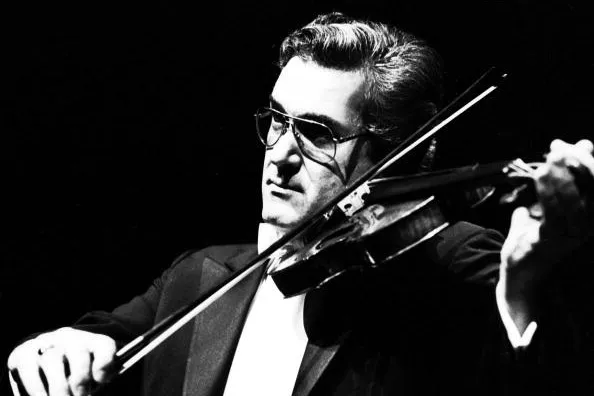
Pinchas Zukerman first reached wide international prominence in the musical circle of friends around Daniel Barenboim and Jacqueline du Pré in the 1960s and ’70s. He currently lives in Canada where he is music director of the National Arts Centre Orchestra in Ottawa. As a conductor he has followed a parallel career since first taking up the baton with the English Chamber Orchestra in 1970.
After drawing the attention of cellist Pablo Casals and Isaac Stern as a violin prodigy in Israel, Zukerman went to New York’s Juilliard School to study with Ivan Galamian. He has a personal sound that is easy to spot – intense, passionate and strong-centred – which enhances a wide range of repertoire, perhaps strongest in the heartlands of the great Romantic concertos as well as Beethoven and Mozart.
In an interview for The Strad a few years ago, Zukerman remarked that a personal sound is something that a violinist is born with and that he/she can develop but not essentially change: ‘It’s about DNA’.
ESSENTIAL RECORDING: Great Violin Concertos – Beethoven, Brahms, Mendelssohn, Tchaikovsky With Chicago Symphony/Daniel Barenboim
DG E453 1422
13 Adolf Busch
(1891-1952) German
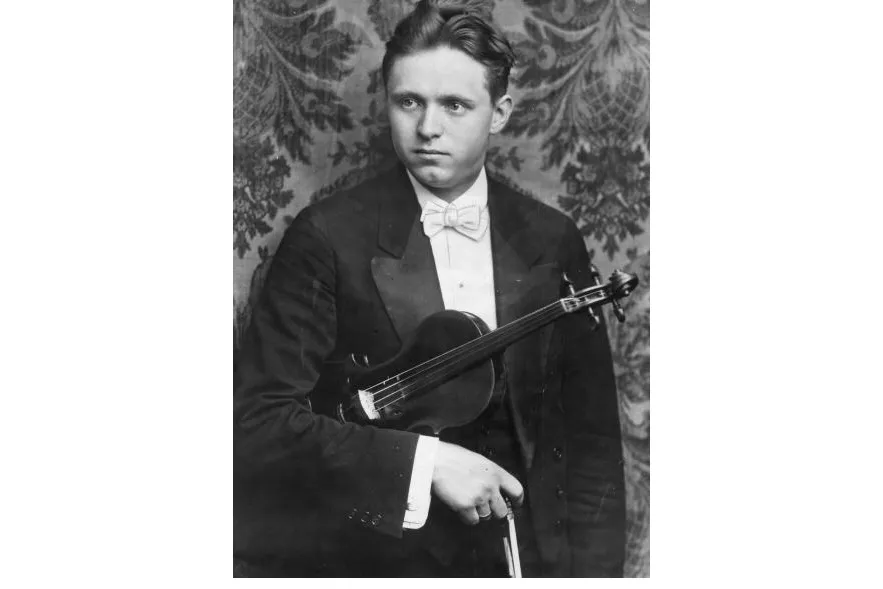
A pupil of Joseph Joachim disciples Willi Hess and Bram Eldering, Busch became revered not only as a solo violinist and composer but also as founder of the Busch Chamber Players and the Malboro Festival, Vermont. He was also the moving spirit behind three distinguished chamber ensembles. These were the Busch Quartet, a duo with pianist (and his future son-in-law) Rudolf Serkin, and the Busch Trio with his cellist brother, Hermann, and Serkin.
Busch’s playing, like Joachim’s, was disciplined, precise and authoritative. His tone was pure and sonorous and he consistently exploited technical adroitness to musical ends, incorporating portamento tastefully, varying vibrato subtly, and bowing with finesse.
He became renowned for his interpretations of Beethoven and Brahms concertos, also championing works by Reger, Suter and Busoni; and his chamber ensembles established their pre-eminence in works by Beethoven, Schubert, Schumann and Brahms. One of the greatest violinists, and one of the most important chamber musicians, of the 20th century.
ESSENTIAL RECORDING: Beethoven: Violin Sonatas Opp. 12/3, 24 & 47 With Rudolf Serkin (piano)
Naxos 8.110954
14 Ivry Gitlis
(1922-2019) Israeli
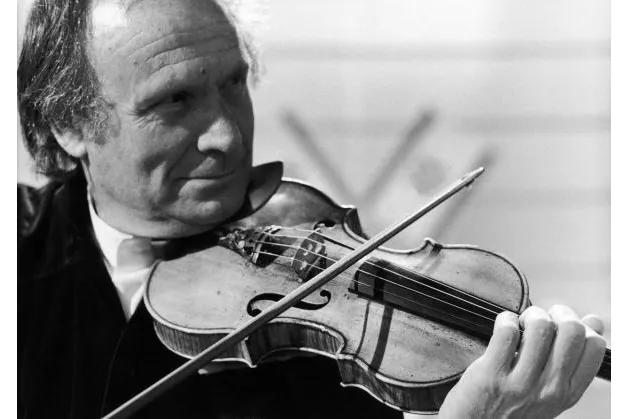
One of the most charismatic and underestimated violinists of his times, Gitlis has been as expert in jazz, pop and gypsy styles as in Classical, Romantic and contemporary repertoire. His performances sometimes seem eccentric and undisciplined but are full of character and inward feeling, emphasising individual expression and musical intuition over textual, stylistic and historical awareness.
Trained principally in Paris, he studied further with George Enescu, Jacques Thibaud and Carl Flesch and began his recording career with an award-winning coupling of Berg’s Violin Concerto and Chamber Concerto.
He toured widely from the 1950s, performing in particular the Berg, Bartók, Sibelius and Stravinsky concertos, championing new music by Maderna, Xenakis and others, and even participating in projects with John Lennon and The Rolling Stones. His technical facility and subtly varied vibrato usage are especially striking. In demand as a teacher, writer, artist, film composer and actor, Gitlis also served as a ‘special ambassador’ to UNESCO. How did he find time among all this to be one of the greatest violinists of our time?
ESSENTIAL RECORDING: The Art of Ivry Gitlis: Violin Concertos by Bartók, Berg, Hindemith, Mendelssohn, Sibelius and more
Brilliant Classics 9145
15 Leonid Kogan
(1924-82) Russian
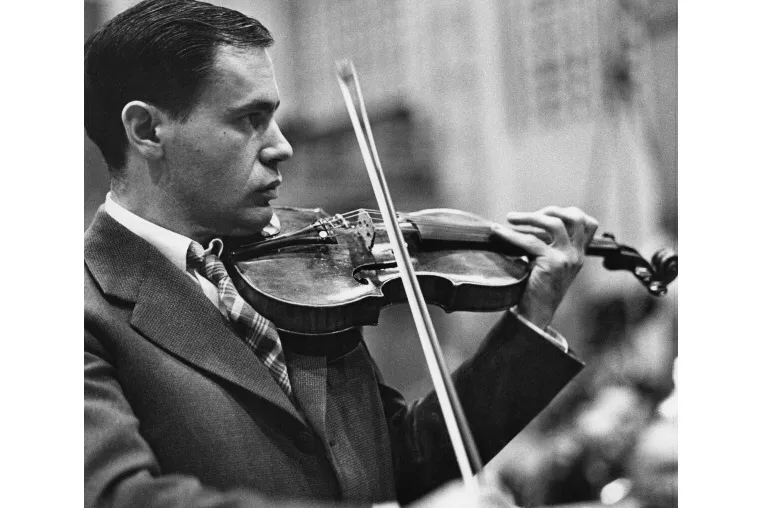
Such was the dominance of David Oistrakh in the Soviet Union that the brilliance of his younger compatriot Leonid Kogan slipped comparatively under the radar.
Born in the Ukraine, Kogan studied in Moscow. A victory at the Queen Elisabeth Competition in Brussels, performing Paganini’s First Concerto, launched his concert career in earnest. A model of restraint both on and off the stage, Kogan’s playing was notable for his immaculate technique and intonation. That, and a purity of sound that saw vibrato kept to a minimum.
Not that this meant lack of passion, as is amply revealed by recordings that range from works by Beethoven and Brahms to those by his Soviet contemporaries, whom he regularly championed. As a chamber musician, in particular, he was in his element. He formed a notable trio with pianist Emil Gilels and cellist Mstislav Rostropovich. Later on in his life, he was accompanied by his daughter Nina.
Sadly, that life came to an all-too-early end. Kogandied aged just 58 on a train on the way to a concert engagement. He had already, though, cemented his place as one of the greatest violinists of his era.
ESSENTIAL RECORDING: Beethoven, Brahms and Franck Violin Sonatas with Nina Kogan (piano)
Orfeo C657051B
Check out Leonid Kogan on Spotify
Greatest violinists of all time: 16 to 20
16 Bronisław Huberman
(1882-1947) Polish
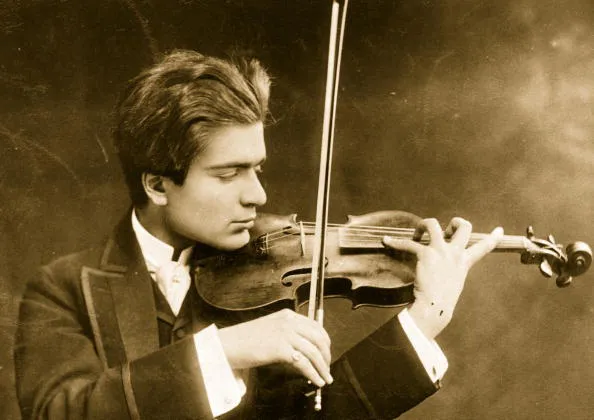
Of his numerous teachers, Huberman credited Carl Grigorovich as his principal influence. A child prodigy, he was praised by Joachim and Brahms. He shot to fame by participating in singer Adelina Patti’s farewell concert in Vienna, 1895.
He became a dominant musical figure worldwide, particularly after 1920, performing the concertos of Bach, Beethoven, Brahms, Mendelssohn, Mozart, Paganini and Tchaikovsky, sonatas and solos by Beethoven, Sarasate and Wieniawski, salon pieces and violin/piano arrangements (notably of Schubert songs).
His interpretations were renowned for their striking individuality, artistry and integrity, even if his technique and style were somewhat retrospective, unpredictable and subjects of deprecatory criticism by some fellow violinists. As such, he may be a controversial choice in our list of greatest violinists.
Nevertheless, he enthusiastically endorsed the use of aluminium bow hair and steel strings. He also retrained his left hand sufficiently to resume his career following injuries suffered in a plane crash in 1937. He opposed the Nazi regime and was instrumental in forming the Palestine Symphony (later Israel Philharmonic) Orchestra in 1936.
ESSENTIAL RECORDING: Beethoven: Violin Concerto in D, Op. 61 with the Vienna Philharmonic/George Szell
Naxos 8.110903
17 Christian Ferras
(1933-82) French
A former child prodigy, throughout the 1950s and ’60s Christian Ferras was among the violin-playing elite. He was still a teenager when he made his debut. That was playing the Beethoven Concerto with Karl Böhm and the Berlin Philharmonic (which we named one of the best orchestras in the world).
Such was Ferras's impact over the following decade that he was signed up by Herbert von Karajan. The unique deal aimed to record the major violin repertoire over 20 discs. In the event the signing was sadly curtailed due to Ferras’s struggles with depression and alcohol.
By the mid-1970s the engagements diary of this prince of violinists was virtually empty. Following a brief comeback when he was reported to be playing better than ever, he tragically took his own life.
Ferras’s playing combined exquisite tonal purity with exemplary technique. Whether playing Mozart sonatas with his long-term playing partner Pierre Barbizet, the Brahms Double Concerto with cellist Paul Tortelier or premiering contemporary works such as the Honegger Sonata, he created the impression of having a hotline to the composer.
ESSENTIAL RECORDING: L’ Art de Christian Ferras
DG 480 6655 (10 CDs)
18 Reinhard Goebel
(b.1952) German
Reinhard Goebel established himself as a Baroque violin soloist and inspirational director of the period-instrument Musica Antiqua Köln. He founded that ensemble in 1973, following violin instruction from Franzjosef Maier, Saschko Gawriloff, Eduard Melkus and Marie Leonhardt, and musicological studies at Cologne University.
Severe right-arm tendonitis restricted his solo playing from 1990. However, he continued to perform with the ensemble, largely bowing his violin left-handed. Renowned for its attention to the details of Baroque style, Musica Antiqua Köln performed, recorded and toured worldwide. Its focus was on historical performance of late 17th- and early 18th-century German music. Composers such as Heinichen, Schmelzer, Biber, Telemann and members of the Bach family featured prominently.
But further tendonitis problems resulted in Goebel dissolving the ensemble in 2007. He then concentrated on a conducting career. The repertoire varied - but he still spent considerable time promoting the music of JS Bach and his contemporaries.
ESSENTIAL RECORDING: Telemann: Sinfonia Spirituosa; String Concertos with Jaap Ter Linden (cello); Musica Antiqua Köln
Deutsche Grammophon E471 4922
19 Frank Peter Zimmerman
(b.1965) German
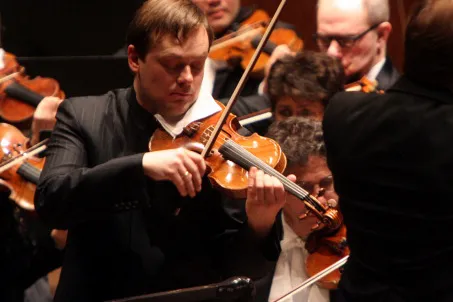
At the heart of Frank Peter Zimmermann’s repertoire are the great violin concertos. ‘I always go over the works I’ve often played as if I had never known them, seeking for fresh perspectives,’ he says. It’s this searching spirit and thoughtful intelligence that distinguishes Zimmermann’s playing. That, andan unflappable technique and pure, warm and strong sound.
After studies in Germany and Amsterdam, the German violinist embarked on his solo career in 1983. Soon, he was performing around the world and recording many of the major concertos for EMI. Zimmermann has also made his mark with contemporary music, premiering works by Matthias Pintscher, Brett Dean and Augusta Read Thomas.
But it’s playing chamber music that gives Zimmermann the most satisfaction. In 2007 he formed the Trio Zimmermann with viola player Antoine Tamestit and cellist Christian Poltéra. Their thrilling Beethoven String Trios CD on the BIS record label won a BBC Music Magazine Chamber Award in 2013.
ESSENTIAL RECORDING: Beethoven: String Trios With Antoine Tamestit (viola), Christian Poltéra (cello)
BIS SACD 1857
Check out Frank Peter Zimmerman on Spotify
20 George Enescu
(1881-1955, Romanian)
George Enescu was a prodigiously gifted musician whose celebrity was limited by his own modesty and dislike of showmanship for its own sake. Not only a violinist, he was Romania’s leading composer, a distinguished conductor and a teacher whose pupils included Yehudi Menuhin, Arthur Grumiaux, Ivry Gitlis, Christian Ferras and Ida Haendel.
From the age of four he studied violin with the gypsy player Lae Chioru and made his first public appearance, aged eight, as a violinist in 1889. Enescu then studied composition and violin at the Paris Conservatoire, supplementing his official violin lessons with the Paris-based Cuban violinist José White. He toured widely as a violinist (both as a solo and chamber musician) and conductor, but regarded his chief vocation as a composer. His unshowily pristine and song-like violin playing is preserved in the few recordings he made in the US during the 1920s, and his 1940s recordings of Bach’s Solo Sonatas and Partitas.
ESSENTIAL RECORDING: The Columbia Solo recordings – works by Chausson, Corelli, Enescu, Handel, Kreisler and Pugnani
Opus Kura OPK 2086
Check out George Enescu on Spotify
Words by Julian Haylock, Jessica Duchen, Robin Stowell, Daniel Jaffé, Jeremy Pound and Rebecca Franks
Greatest violinists of all time: how did we get our results?
Who were the 100 violinists that took part in our poll? And whom did they each nominate? Click here to see the voting in full.